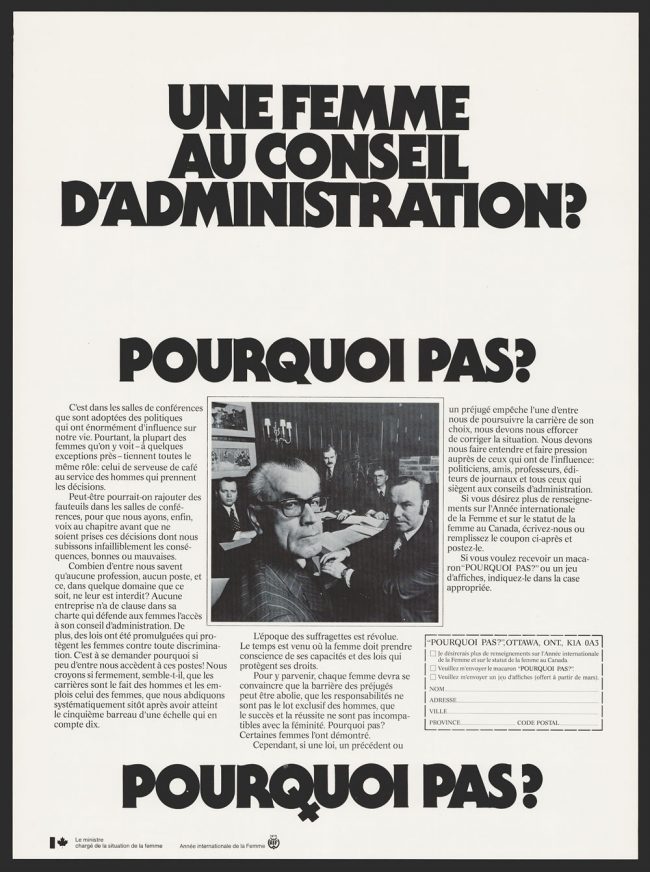The Boys’ Club is not only a place or a structure occupied by men: it is the means by which masculinity becomes a gendered sex which is not really a gender because it represents the entire world. The Boys’ Club renders man (white, heterosexual and middle-class) the representative of the neutral and the universal. It makes the masculine dominate the feminine, the white the racialized, the rich the poor, the heterosexual the queer, etc. But it is not only their presence which gives men power, it is the way they organize themselves and find themselves together, seated around a table, an icon, an ideal…
The Boys’ Club is a form of networking. It is a place or a structure where decisions are made amongst men (#déciderentrehommes). The Boys’ Club corresponds to what some call patriarchy (Delphy [1]1Recherches féministes
Christine Delphy, L’ennemi principal, II. Penser le genre
2001, Guillaumin [2]2Recherches féministes
Nicole-Claude Mathieu : L’anatomie politique. Catégorisations et idéologies du sexe
1992, Mathieu [3]3Sociologie et sociétés
Femmes et théories de la société: remarques sur les effets théoriques de la colère des opprimées
1981), or others male domination (Bourdieu [4]4Actes de la recherche en sciences sociales
La domination masculine
1990): It is an organization where men are hierarchically superior to women (and where some men are superior to other men), where some are subjects and others are objects of exchange.
But this structure depends on men’s relationships amongst themselves. Thus, we are not here interested in masculinity as such, or in man as an individual, in his singularity; our interest is to track the “club” in order to think about the systemic dimension of gendered sex, how masculinity is formed, how it figures (and therefore, how it can also be disfigured) within social space.
A world unto itself
If we go back to the British origins of the expression, we learn that Boys’ Clubs were popularized in London at the beginning of the XIXth century [5]5Lumen
"Clubbability": A Revolution in London Sociability?
2016. They were created, notably, in response to the domestic space delegated to women. These clubs were places of retreat where men could not only escape the marital and family space, but invent a space in their own image [6]6The Journal of British Studies
A Flight to Domesticity? Making a Home in the Gentlemen's Clubs of London, 1880-1914
2006.
Over time, Boys’ Clubs came to designate:
> An organization that traditionally excludes women and is controlled by men.
> A group of older and wealthy men who hold political power.
> A group of persons in a position of power who use this power, most often indirectly, for their own benefit. (In England today, the Old Boys’ Club remains a network of men from private boys’ schools, who become “old boys” upon graduation.)
Finally, Boys’ Club refers to the desire to preserve social elites. As they say: “It is not what you know that counts, it is who you know.” The Boys’ Club is a tight-knit group of men-friends who protect each other.

The group as a power factory
The club is therefore a very precise type of grouping. It is not an indistinct crowd, but truly a network, a clan, a family, a regiment, a team, a council, a fraternity, a government… that is to say a group whose members are linked—dependent upon one another, relate to each other and are united by a common interest, a shared belief, an ideal to which all adhere.
It is thus necessary to hear these words (my emphasis):
Power in the substantive sense, “the” power, doesn’t exist. What I mean is this. The idea that there is either located at—or emanating from—a given point something which is a ‘power’ seems to me to be based on a misguided analysis, one which at all events fails to account for a considerable number of phenomena. In reality power means relations, a more-or-less organised, hierarchical, co-ordinated cluster of relations. Michel Foucault [7]7in Power/knowledge: Selected Interviews and Other Writings, 1972-1977, ed. C. Gordon, transl. C. Gordon et al., New York, Pantheon Books
The Confession of the Flesh [1977]
1980One must engage masculinity critically as ideology, as institutionally embedded within a field of power, as a set of practices engaged by groups of men. Michael Kimmel [8]8Oxford, Oxford University Press
Manhood in America: A Cultural History
2011 [3e éd.]Manliness, it can be seen, is an eminently relational concept, constructed in front of and for other men and against femininity, is a kind of fear of the female, firstly in oneself.
Pierre Bourdieu [9]9transl. R. Nice, Stanford: Stanford University Press
Masculine Domination [1998]
2001
In sum, the Boys’ Club is an organization that traditionally excludes women and is constituted by a group of older men, wealthy and white, who have political power. A dimension of gender studies is to think about masculinity from this state constituted by the group.
If men form a series, in Iris Marion Young’s sense [10]10Recherches féministes
Le genre, structure sérielle: penser les femmes comme un groupe social
2007 [1994], they are essentially a group insofar as they are actively and not passively related to each other. It is difficult to imagine a series of men standing next to each other just to look pretty as women are obliged to when submitting to the standard image of girls in a series. As Nelly Arcan wrote in Putain (2001, Whore, 2004): “Men do not need to be put on display”.
Instead, we imagine men turned towards each other, forming a closed circle, linked to each other by a relationship that has everything to do with power, a power factory that decides who is the strongest in this immense schoolyard that is our world.
The white, male, heterosexual: the true
Todd Reeser [11]11Toronto, Wiley-Blackwell
Masculinities in Theory: An Introduction
2010 focuses on the fact that masculinity is anonymous, trivialized, “unmarked” (in the sense of unmarked police cars), immaculate. Men are most often considered as being without gender, in the same way that whites are perceived as non-racialized. The male (and in particular the white male, which, as Carbado says [12]12Berkeley Women's Law Journal
Straight out of the Closet
2000, is without a doubt male and represents all men because he is white) is understood as the universal. This is how he goes unnoticed. In this sense, if we must see masculinity as an ideology, Todd Reeser says, it is because it concerns subjectivities related to power. Some institutions (the army, for example [13]13Labour/Le travail
Manhood and the Militia Myth: Masculinity, Class and Militarism in Ontario, 1902-1914
1998) have an interest in instituting masculinity. And this institution of the masculine is carried out not only with regards to those identified as being women, but also with regards to those identified as other men [14]14Nouvelles pratiques sociales
Les hommes et les études féministes
1990: on the one hand, there are real men, seen and recognized as such, idealized and emulated and, on the other hand, there are those who are not entirely masculine or not enough or that are not as masculine as they should be.
But there is no power without a counter-power. And in this sense, one of the objectives of gender studies is to show, in an intersectional perspective [15]15Nouvelles pratiques sociales
Intersectionnalité, féminismes et masculinités: une réflexion sur les rapports sociaux de genre et autres relations de pouvoir
2014, the diversity of Boys’ Clubs in order to ask what types of masculinities escape them, or are marginalized. What men are more or less visible [16]16Recherches féministes
Le discours de la «crise de la masculinité» comme refus de l’égalité entre les sexes: histoire d’une rhétorique antiféministe
2012? What is the place of the racialized [17]17in Black male partial (in)visibility syndrome, Ph.D. Thesis, University of Illinois
Black Masculinities Expressed Through, and Constrained by Brotherhood
2014, queer, trans, poor… men. Do they participate in the Boys’ Club in the same way, and if not, how do they participate? How is their masculinity expressed and what form does their resistance take? In what ways, thanks to this diversity of bodies, experiences, sensitivities… are Boys’ Clubs undermined, defeated, reimagined?
That is today’s challenge. On the one hand, we must identify the Boys’ Club wherever it manifests itself and, on the other hand, we must think about ways to reconfigure it.
Read also
Spirale, no 215, “Les masculinités”, Sandrina Joseph (ed.), 2007.
Recherches féministes, vol. 11, no 2, “Ils changent, disent-ils”, Huguette Dagenais and Anne-Marie Devreux (eds.), 1998.
Translated from French by Peter Keating.

